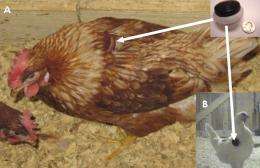MSU studies use of wireless sensors to monitor chicken well-being

(PhysOrg.com) -- A team of Michigan State University researchers will explore the use of new wireless technology to determine its effectiveness in monitoring the welfare of egg-laying chickens.
Using a grant of $375,000 from the U.S. Department of Agriculture, the researchers will test wearable sensors that will monitor how hens use space and resources in non-cage environments.
The team has developed a hen-mountable wireless sensor system for tracking a hen’s activity profile, including its movement with respect to other hens and fixed items such as nest-boxes, perches and water station. The sensor weighs less than one ounce.
“Wearable and networked wireless sensor technology is currently being explored in academia and in the industry primarily for human health monitoring,” said Subir Biswas, an associate professor of electrical and computer engineering and one of the team members. “We wanted to develop applications for such technology in the context of animal health and well-being monitoring.”
“The purpose of the USDA grant is to use the wearable sensors to understand how laying hens use space and resources, like perches and nest boxes, in non-cage housing systems,” said Janice Siegford, team member and professor of animal science. “Ultimately, the sensors will also tell us what behavior a hen is performing. Is she laying an egg? Eating? Or roosting on a perch? Does she fly or walk to move around?”
The information will serve as an important basis for how to provide hens with key resources and how much space they really need. Such information will provide a scientific basis for designing non-cage housing systems for laying hens that provide the best possible welfare for the animals.
The long-term implications include improving non-cage housing design and creating an automated monitoring system to monitor welfare with potential commercial applications.
“The general public is showing concern over how animals in production are housed and whether they can show natural behaviors,” Siegford said. “In response, the egg industry in the United States is considering adopting non-cage housing systems for their laying hens.
“But non-cage systems that are poorly designed can cause health problems and can lead to feather pecking and cannibalism. So in order to design non-cage systems that really improve the welfare of laying hens, we need to understand how these housing systems affect the behavior and health of the individual birds living in these systems.”
Other team members include Janice Swanson, a professor of animal science and large animal clinical science; Darrin Karcher from the Department of Animal Science; Ruth Newberry and Marvin Pitts from Washington State University; and Joy Mench from University of California, Davis.
Provided by Michigan State University















